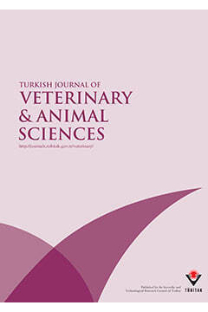Fractures in young, single-humped camels (Camelus dromedarius)
Key words: Fracture, classification, treatment, young camels
Fractures in young, single-humped camels (Camelus dromedarius)
Key words: Fracture, classification, treatment, young camels,
___
- Jennings, P.B.: Th e practice of large animal surgery. Volume II. WB Sunders Co., Philadelphia, 1984; 816-852. 2. Gahlot, T.K.: Fractures. In: Gahlot, T.K. Ed. Selected Topics on Camelids. Sankhla Printers, Sugan Niwas Chanfan Sagar Well, Bikaner, India, 2000; 382-407.
- Ramadan, R.O.: Fractures. In: Ramadan, R.O. Ed. Surgery and Radiology of the Dromedary Camel. 1st edn. King Faisal University, Kingdom of Saudi Arabia, 1994; 226-250. 4. Ramadan, R.O.: Incidence, classifi cation and treatment of 179 fractures in camels (Camelus dromedarius). Proc. 1st Internatl. Camel Conf., Dubai, Feb 2-6, 1992; 347-351.
- Singh, A.P., Mirakhur, K.K., Nigam, J.M.: A study of the incidence and anatomical locations of fractures in caprine, equine and camel. Indian J. Vet. Surg., 1983; 4: 61-66. 6. Johnson, C.R., Baird, A.N., Baird, D.K., Wenzel, J.G.: Long- bone fractures in llamas: six cases (1993-1998). J. Am. Vet. Med. Assoc., 2000; 216: 1291-1293. 7. Newman, K.D., Anderson, D.E.: Humerus fractures in llamas and alpacas: seven cases (1998-2004). Vet. Surg., 2007; 36: 68- 73.
- Shoemaker, R.W., Wilson, D.G.: Surgical repair of femoral fractures in New World camelids: fi ve cases (1996-2003). Aust. Vet. J., 2007; 85: 148-152.
- Kaneps, A.J., Schmotzer, W.B., Huber, M.J., Riebold, T.W., Watrous, B.J., Arnold, J.S.: Fracture repair with transfi xation and fi berglass cast in llamas and small ruminants. J. Am. Vet. Med. Assoc., 1989; 195: 1257-1261.
- St. Jean, G., Bramlage, L.R., Constable, P.D.: Repair of fracture of the proximal portion of the radius and ulna in a llama. J. Am. Vet. Med. Assoc., 1989; 194: 1309-1311.
- Squire, K.R., Boehm, P.N.: External fi xation repair of a displaced comminuted radial fracture in a juvenile camel. J. Am. Vet. Med. Assoc., 1991; 199: 769-71.
- Gahlot, T.K., Chouhan, D.S.: Fractures in dromedary (Camelus dromedarius) - A retrospective study. J. Camel Pract. Res., 1994; 1: 9-14.
- Fowler, M.E.: Surgery. In: Fowler, M.E. Ed. Medicine and Surgery of South American Camelids: llama, alpaca, vicuna, guanaco, 2nd edn., Iowa State University Press, 1998; 108-147.
- Gangl, M., Grulke, S., Serteyn, D., Touati, K.: Retrospective study of 99 cases of bone fractures in cattle treated by external coaptation or confi nement. Vet. Rec., 2006; 158: 264-268.
- Al-Ani, F.K.: Camel Management and Husbandry. In: Al-Ani, F.K. Ed. Camel Management and Diseases. 1st edn., Al-Sharq Printing Press, Amman, Jordan, 2004; 69-90.
- Singh, A.P., Nigam, J.M.: Radiography of some disorders of head and neck regions in camels. Indian Vet. J., 1982; 59: 153- 155.
- Semevolos, S.A., Huber, M.J., Parker, J.E., Reed, S.K.: Complications aft er orthopedic surgery in alpacas and llamas: 24 cases (2000-2006). Vet. Surg., 2008; 37: 22-26.
- ISSN: 1300-0128
- Yayın Aralığı: 6
- Yayıncı: TÜBİTAK
Caesarean operation in two farmed red deer (Cervus elaphus)
Sinem Özlem ENGİNLER, Mehmet Can GÜNDÜZ, Tuğba Seval Fatma TOYDEMİR
Fractures in young, single-humped camels (Camelus dromedarius)
Ahmed Fathy AHMED, Fahd Abdullah Al-SOBAYIL
Unusual anal atresia in a lamb
Antioxidative and antimicrobial effects of garlic in ground camel meat
Hamid R. GHEISARI, Vahid R. RANJBAR
Congenital lymphoma of B-cell lineage in a newborn calf
Mehmet Alper ÇETİNKAYA, Alper DEMİRUTKU
Performance analysis of a two stage pad cooling system in broiler houses
Metin PETEK, Serdal DİKMEN, Mehmet Mustafa OĞAN
Optimum timing for operation in bitches with pyometra related to endotoxemia
Melih UÇMAK, Çağatay TEK, Mehmet C. GÜNDÜZ, Ahmet SABUNCU, Adem ŞENÜNVER
Thermography in the assessment of equine lameness
